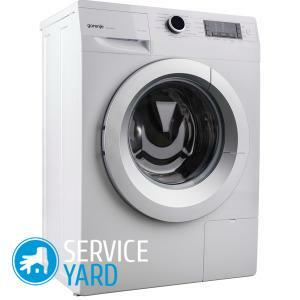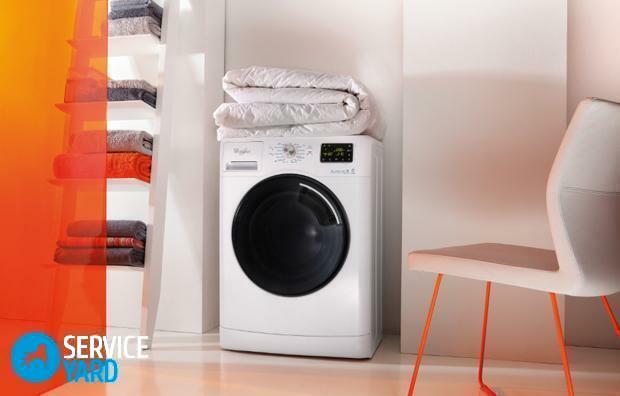
- Why is classification necessary?
- Washing power consumption class of washing machine
- Washing efficiency class
- Washing machine efficiency class
- Washing machine washing classes - characteristics
- Which washing machine is better?
- Price of the machine
Buying a household appliance for washing clothes, not everyone understands what class of spin is better in washing machines. But this is one of the important characteristics of this technique. This article will help in this matter, as well as what is the energy consumption class of the washing machine and what are the washing-machine washing classes.
to the contents ↑Why is classification necessary?
To ensure that the quality of household appliances was easier to assess and the assessment was more understandable for all consumers, regardless of the country of residence, in European countries, as well as in many others, a unified system was introduced. With regard to washing machines, the quality is determined by the estimated levels of washing, power consumption and spinning - from the maximum A to the minimum G.
Each letter value for the machine is determined by comparing the values of the test sample to the values of the reference instrument. What do these letters mean and how to choose a really high-quality technique? This is described in more detail below.
to the contents ↑Energy consumption class of the washing machine
The higher the energy consumption class of the washing machine, the less energy it uses during the full cycle of its operation.
Important! Until 2002 there were only seven levels of energy consumption. Evaluation A was answered by machines that consumed less than 0.19 kWh / kg in the course of their work.
To date, there are even more profitable models, the estimation of their energy consumption is defined as A +, A ++, A +++.Such a marking assumes electricity consumption of less than 0.17 kWh / kg, which allows consumers to significantly save on utility bills.
For comparison, we give the characteristics of all energy levels:
- Level B is considered economical and indicates consumption of electricity within the limits of 0.19-0.23 kWh / kg.
- С - indicates consumption of electricity 0,23-0,27 kWh / kg.
- D - characterizes the machine as a device of average profitability. The electricity consumption is 0.27-0.31 kWh / kg.
- E - indicates that the machine has a rather high energy consumption - 0.31-0.35 kWh / kg.
- F - characterized by a very high electricity consumption - 0.35-0.39 kWh / kg.
- G - means that the machine is not very economical, since it consumes more than 0.39 kWh / kg of electricity.
Important! In connection with the demand for better equipment, machines with a power consumption level below D are almost impossible to meet in the market of goods of this purpose. And to buy such household appliances is not recommended, as the savings in the purchase will result in large financial losses in the process of using the equipment.
The squeezing class has almost no effect on the safety of the appliance in flats with problem wiring. As a rule, the machine can work in parallel with a large number of other household appliances included in the electric network: a TV set, a refrigerator, a microwave oven.
to content ↑Washing efficiency class
What is the washing machine washing class and what does it affect? This is one of the most important indicators of the appliance of home appliances and shows how well your clothes will be washed.
Many people are interested in the question, what is the best washing class in washing machines. Sales consultants in specialized stores advise buying cars that have a washing class A. What does this mean and is the right choice in this case?
Such an evaluation is assigned to the device as a result of testing machines for the ability to wash various types of contamination from clothing under the same conditions.
Important! It is worth remembering that this affects not only the technique, but also the quality of the detergent. Therefore, choosing a washing level B and using a good quality powder, you will not lose at all. And the machine itself will cost you an order of magnitude cheaper.
As for household appliances with a washing level of C and below, there are few such in the current market, as they are not particularly in demand. After all, no one wants to spend time on hand washing at such a fast pace of life. And if you already spend money on technology, then buy it wisely and profitably.
to the table of contents ↑The efficiency class of washing machines
With the concept of pressing, it's probably all familiar. But that's what a few people know about the class of spinning in a washing machine. This parameter directly depends on the number of revolutions that the machine is able to perform per minute when removing moisture from the laundry. In modern devices, the speed can be from 600 to 1600 revolutions per minute.
Important! Most often there are models with parameters of 800-1200 rpm. This is enough for a good twisting of most things.
The quality of moisture removal from fabric things, that is, the efficiency class of the spin is characterized by the percentage of moisture that remains in the laundry after washing.
to the table of contents ↑Washing machine spin classes -
characteristics To understand what equipment will be more appropriate in your life, you need to know what level of convenience you will get from purchasing a particular model. When deciding what type of spin is better in washing machines, consider the following features of each option.
Level A
If the indicated technique shows that it has a spin class A, then it means the following:
- The residual moisture that the laundry has after the cycle in the machine with the maximum level of twisting is less than 45%.
- The number of revolutions per minute at the final stage of the machine's operation exceeds 1500.
- The twisting will be too intense.
Important! This technique is recommended for processing coarse high-density fabrics.
Level In
The letter B in the vehicle's technical passport indicates the following parameters:
- The humidity remaining in the laundry is 45-54%.
- The machine makes 1200-1500 revolutions per minute at the final stage of its work.
- Clothing tightening is intense.
Important! Such parameters are ideally suited for unscrewing terry fabrics.
Level C
The following parameters are inherent in this evaluation:
- The residual moisture content is 54 to 63%.
- The number of revolutions per minute is in the range from 1000 to 1200.
- The twisting is defined as strong.
- Suitable for processing coarse fabrics.

Level D
This marking indicates the following parameters:
- Residual humidity in washed laundry is 63-72%.
- The machine is capable of making 800-1000 rpm.
- Twisting occurs in a fairly intensive mode.
Important! Suitable for processing cotton and synthetic fabrics.
Level E
Do not be alarmed if the model you select has a similar label. Twisting level E has quite good characteristics:
- The residual humidity is 72-81%.
- This rating is assigned to devices with a speed of 600-800 per minute.
- This level is intense in terms of twisting.
Important! Recommended for handling delicate things.
Level F
If the degree of dryness of laundry after washing is of little importance to you, then you can consider the variants of machines with this level of moisture removal:
- The humidity of things after wringing is 81-90%.
- Number of revolutions per minute 400-600.
- The level of unscrewing of laundry is weak.
Important! It will be an excellent choice for processing fine fabrics.
Level G
Machines with this evaluation of the quality of twisting are not in great demand, as models with previous characteristics. But, nevertheless, they are present in the market and find their buyer:
- The residual humidity is more than 90%.
- The machine makes less than 400 rpm at the final stage of its operation.
- The twisting is very weak and equates to manual removal of moisture.
Important! Suitable for removing moisture from very thin and delicate fabrics.
to the contents ↑Which washing machine is better?
Although clothes with a higher spin class will be less wet and, accordingly - faster dry, but not always necessary and justified. It should be understood that the more intensively a household appliance will press fabric products, the stronger they will twist and deteriorate in the process. Moreover, not all fabric products can be twisted in too strong or very strong mode.
Therefore, do not consider options with a spin of 1600 revolutions, if you buy the device for home use. In addition, if the machine will have a small size, it is possible that it will make jumps and movements during the unscrewing of the laundry.
Important! The dryness of the laundry is affected not only by the number of revolutions of the drum, but also by the permeability of the material. After all, the removal of moisture from the laundry in an economic machine is to push water through centrifugal force through the fabric. Therefore, different things at the same number of revolutions can have different residual humidity.
The spinning class in washing machines also includes parameters such as the time during which the complete cycle of moisture removal and drum diameter is performed. For example, more effective will be the twisting of the laundry at the same speed for a machine with a large diameter of the drum. If the machines have the same drum diameter and the same number of revolutions, then the device that has a longer time to perform this procedure will better cope with the removal of moisture from the tissues.
Energy parameters that affect the financial security of the family, and the quality of washing, since this is the direct purpose of the machine and I would like it to be 100% complete, can be called very important criteria for choosing household appliances of this purpose. But the quality of pressing things is purely a parameter of the user's convenience, because clothes can always be dried in a special drying or fresh air and this does not worsen the condition of clothes.
to the contents ↑machine price As a rule, the higher the letter value of energy consumption, washing and spinning the machine, the more expensive it costs. But this rule does not apply to all models. The cost of household appliances depends a lot on brand recognition. Therefore, whether to buy a car that has a class of washing A little-known manufacturer, or a device with the worst characteristics of a well-known brand - it's up to you.
If you did not find the alphabetic classification on the selected machine, this does not mean that it is of poor quality. Just this model is not supplied to the countries of the European Union. Now, knowing what is the class of pressing in the washing machine, power consumption and washing, you can easily determine the quality model of the machine by its technical characteristics.
